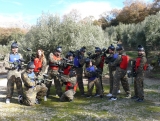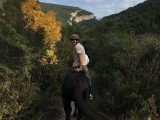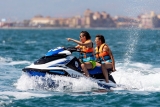Most of us associate moderate air consumption with a good dive. Among other reasons, because it implies a longer dive time.
Why do some divers consume much more air than others?
Many factors influence our air consumption, primarily physiological and individual. Our morphology and physical condition, especially aerobic endurance, and of course, our diving technique (movements, buoyancy, equipment use...) play a decisive role. Just as a 1,000 cc car doesn’t consume the same as a 3,000 cc one, neither does a 50 kg woman with 4 litres of lung capacity compared to a 95 kg man with 6.5 litres. The latter needs much more energy to move and requires more fuel (in this case, the oxygen in the air) to do so.

Another key factor is how we use that fuel. A person in good aerobic condition (the type of exercise diving falls under) makes better use of the oxygen they consume than a more sedentary individual. In other words, for the same given exercise (any dive), they need less air to complete it (because their heart beats slower and their muscle cells use oxygen more efficiently to perform the same work).
What techniques or skills can help extend dive time?
An experienced diver, like an experienced runner, knows how to economise unnecessary effort. Diving is a contemplative activity, so let’s focus on using our eyes and minimise arm and leg movement. Achieving neutral buoyancy is essential. We must be able to balance ourselves using our lungs and the buoyancy compensator (BC) at all times. Thanks to a diving course, you’ll learn all the keys to this. The first time a diver manages to enjoy this throughout an entire dive... they never forget it. It’s an indescribable feeling—it’s like flying.
Just as you shouldn’t use your legs more than necessary for propulsion, avoid using your arms to swim. Keep them together under your chest, where they offer less resistance in the water.

The "hare diver"—the one who thinks the most interesting sight is behind the next rock, and then the next, and so on, covering more miles than anyone—isn’t the ideal buddy.
Most of the time, they miss the dive’s most interesting details and tend to have high air consumption. So, swim only when necessary, take advantage of gravity, currents, and any situation that lets you glide with minimal effort. Personally, I prefer the "tortoise diver," who scrutinises every crevice with their torch, unhurried and stress-free. Air consumption is directly linked to your heart and breathing rate during the dive. Hence, if the dive unfolds in the most relaxed and slow-paced conditions, the diver’s endurance increases.

Breathing Underwater
We all know that most relaxation disciplines use breathing as a fundamental element to achieve that state. Yoga, stretching, various martial arts, etc., are some examples. In scuba diving, adjusting your breathing is also key to enjoying your dives more. Some aspects to consider:
- Take inhalations as deep as necessary. Short, shallow breaths mean you’ll need to breathe more often to keep your tissues oxygenated.
- Exhalations should be as long as possible, fully emptying the lungs to completely renew the air.
- Pause between inhalation and exhalation. The duration depends on your fitness and experience. But beware: this isn’t about holding your breath for long periods, forcing deeper inhalations than normal, which would have the opposite effect.
- Moreover, excessively long breath-holding reduces O2 partial pressure and increases CO2, which, in some cases due to poor ventilation, can lead to post-dive headaches. The pause should last only as long as it feels comfortable. At first, counting to three or five may help regulate your breathing rhythm. With experience, it becomes second nature.
- If stress or exercise intensity (e.g., strong current) leaves you overly fatigued, stop, hold onto something, and fully recover your normal breathing rhythm.

Other Factors Affecting Air Consumption
- Depth. This is a direct factor. The deeper you go, the higher the consumption.
- Simply account for this when planning your dive and choose the right tank size for your profile.
- Comfort. A wetsuit or BC that’s too tight can restrict chest expansion, hindering proper breathing. Keep it slightly looser on the surface and adjust as you descend or reach the bottom.
- Good hydrodynamics. Diver and gear should form a compact unit to minimise drag. An overinflated BC creates resistance. Hanging items like torches, hoses, or cameras also impede movement.
- Proper thermal protection. Diving in warm waters reduces consumption compared to very cold waters, where it increases. The body’s constant temperature regulation spikes energy use. Poor insulation in cold water leads to heat loss and higher consumption. For example, using a rebreather—which heats the gas mix via its CO2-absorbing soda lime filter—is better in cold waters, as it helps maintain thermal balance.

In any case, always wear a suit suited to the water temperature, plus gloves and a hood if needed.
Start the dive at the most interesting point whenever possible. Surface swim if boat traffic and currents allow, and descend at the exact spot.
- Avoid unnecessary air loss, but don’t obsess over it.
- Continuously inflating and deflating your BC, constantly clearing flooded or fogged masks, or small leaks from O-rings, hoses, or a free-flowing regulator are avoidable. Check your gear and maintain it meticulously—it won’t "fail you" repeatedly.
- As for the BC, leave the buttons alone and use them sparingly. Learn to use your lungs for buoyancy control.
- Exercise regularly. Your health will thank you, and your endurance will improve. Following these tips helps avoid back strain from always diving with larger tanks.

Above all, the key is to observe experienced divers and practise our advice as much as possible until you become a true "TDI" diver.











